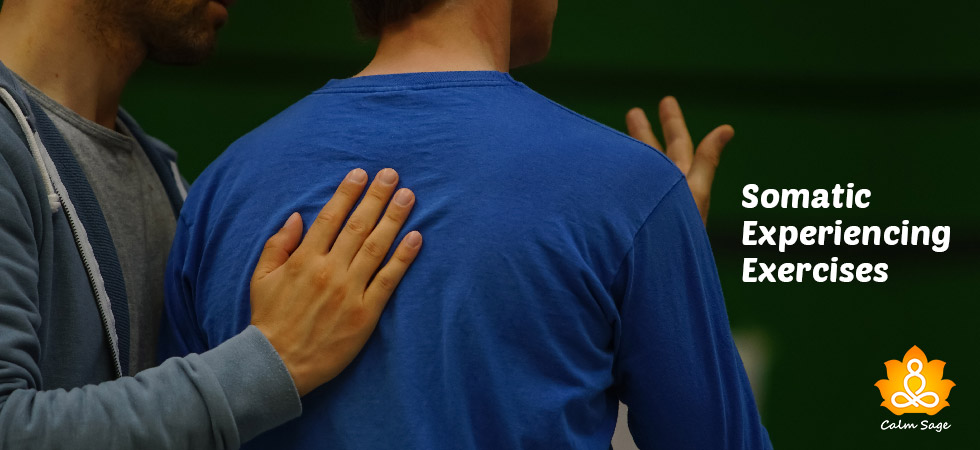What Is Somatic Experiencing? 4 Somatic Exercises To Heal From Trauma

You might’ve heard of somatic therapy but have you wondered what exactly comes under somatic therapy? Somatic exercise is a practice that focuses on the mind-body connection to help you understand your internal areas of discomfort and imbalance.
These somatic therapy exercises can help you understand your mind-body connection better. Experts in somatic healing believe that knowing this connection, combined with movements, can help you heal and make your way towards wellness.
These somatic healing techniques can help you increase body or physical awareness. Exercises such as tai chi and qi gong are examples of healing practices using movements and relaxation techniques.
In this article, I’ve combined for you 5 easy to practice somatic techniques to help you heal.
What Is Somatic Experiencing Therapy?
Somatic experiencing therapy was derived by Dr. Peter Levine. It is a body-centered approach which focuses on relieving the pain, trauma, grief and anxiety that we have stored in us. It prioritizes the mind and body connection and focuses on both physical and psychological symptoms of various mental health conditions.
Dr. Levine believed that traumatic events and experiences can disturb the normal functioning of our nervous system. This dysfunction stops you from completely processing your thoughts, feelings and experiences.
Somatic experiencing aims at identifying the bodily sensation that occurs because of some mental health condition. They then work through those bodily sensations to begin healing.
Now that you know what somatic therapy is, let’s move on to somatic exercises and techniques that can help you heal from trauma…
Somatic Therapy Exercises to Help You Heal:
Note: It is recommended that you start somatic exercises under the supervision of a trained practitioner. Trained therapists can help you understand the movements and their impact on you better.
Somatic exercises usually include movements and all through the exercises you are required to focus on the internal experiences with each movement and broaden your internal awareness. Somatic healing techniques can be:
1. Grounding
Grounding exercises help you find your center and keep your focus on the present moment. With grounding techniques, you can keep your mind off your pain and distress. This technique can work well if you’re struggling with trauma or dissociation.
Grounding exercises can include:
- Running cold water over your hands
- Practicing movements to make you feel comfortable such as dancing, stretching, jogging in place, etc.
- Practicing breathing exercises such as 4-7-8 breathing technique
- Practicing progressive muscle relaxation (PMR) by deliberately tensing muscles and then releasing them gradually
2. Self-Regulation
Self-regulation is another somatic therapy technique best for trauma. This technique helps you guide your emotions to a safe place when they feel overwhelming or distressing. Self-regulation, in somatic therapy, is about addressing our nervous system.
Some of the somatic experiencing techniques, you can try at home to release emotions stuck in your body, can be:
- Self-hugging: Hugging yourself can help release oxytocin, the love hormone, and can make you feel safe and relaxed
- Tap different parts of your body: Doing this will not only help you ground yourself back to the present but will also help you reconnect with your boundaries and feel safe
3. Body Scans
The body scan exercise is another best somatic healing technique that you can use to help you relax. To try body scan meditation you can try the following:
- Get into a comfortable position. You can stay seated if it makes you feel comfortable.
- Focus on your body. Start from your feet. Feel your feet on the ground and move up from there to ankles, knees, and thighs.
- Identify all the sensations you feel in your body as you do the scan
- If you feel any tension, take a deep breath, and on the exhale, release the tension from the body part and move on to the next.
- Continue this scan onto your upper body next. Don’t forget to include the stomach, lungs, and heart.
- In the end, keep your focus on your shoulders, neck, head, and face.
3. Resourcing
Resourcing is another body-oriented, somatic healing technique. It is better to perform resourcing under the supervision of a trained somatic therapist. You can practice this technique at home by creating a safe space in your mind to help you release stress.
This somatic exercise may take time to practice so it’s recommended you practice this technique when you’re not focused on your distress.
You can try practicing resourcing by:
- Creating a safe place inside your head. Think about your happy place or you can visualize a new safe place. Focus on the sensations such as sounds, colors, smell, etc.
- Think about people who make you feel safe and happy. You can visualize the happy moments you spent with them.
4. Alexander Technique
This technique is another somatic healing exercise that can help you release pain and feel relaxed. Moreover, this exercise can also help you identify and let go of harmful habits built by stress.
This is one of the best techniques if you have stiff muscles. This exercise helps you to become self-aware of your body movements, posture, and breathing. You can practice this technique by sitting down, standing, or lounging.
Related Read: Is It Okay To Meditate Lying Down? How to Meditate Lying Down?
Final Thoughts
Apart from the above mentioned somatic therapy techniques, other exercises can be considered somatic:
Among others. With somatic therapy techniques, you can learn to reconnect with your body and become aware of your body movements, emotions, and the overall mind-body connection. There is still evidence required on certain somatic therapy techniques.
However, somatic therapy techniques can help increase emotional awareness, relieve pain, and improve body movements. If you’re ready to try somatic healing techniques, you can watch guided exercises or consult a professional practitioner to help ease you into the practice.
For all ages and body types, somatic techniques can be beneficial. These techniques can help you connect your mind with your body and teach you to live in the present moment while releasing tensed muscles.
I hope this article helped you understand the different somatic therapy techniques you can try at home. If you liked this blog, let us know in the comments below! You can also write to us at info@calmsage.com for more!
Take Care!




















